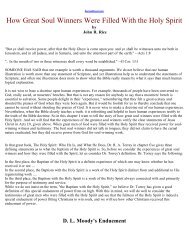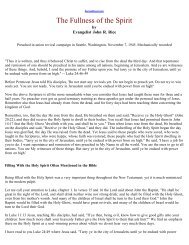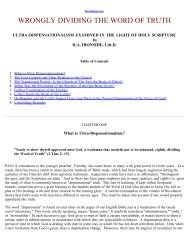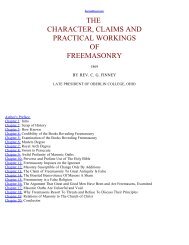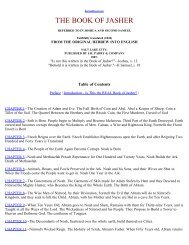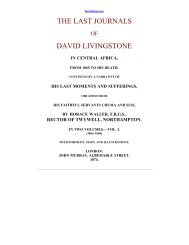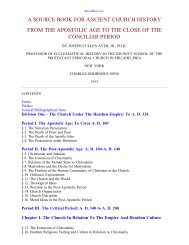Legends of Babylon and Egypt in Relation to Hebrew Tradition.pdf
Legends of Babylon and Egypt in Relation to Hebrew Tradition.pdf
Legends of Babylon and Egypt in Relation to Hebrew Tradition.pdf
Create successful ePaper yourself
Turn your PDF publications into a flip-book with our unique Google optimized e-Paper software.
material effects upon the native population <strong>of</strong> Syria, which followed the westward advance <strong>of</strong> Assyria <strong>in</strong> the eighth<br />
century. We realize not only the read<strong>in</strong>ess <strong>of</strong> one party <strong>in</strong> the state <strong>to</strong> defeat its rival with the help <strong>of</strong> Assyrian support,<br />
but also the manner <strong>in</strong> which the life <strong>and</strong> activities <strong>of</strong> the nation as a whole were unavoidably affected by their action.<br />
Other Hittite-Aramaean <strong>and</strong> Phoenician monuments, as yet undocumented with literary records, exhibit a strange but<br />
not unpleas<strong>in</strong>g mixture <strong>of</strong> foreign /motifs/, such as we see on the stele from Amrith[1] <strong>in</strong> the <strong>in</strong>l<strong>and</strong> district <strong>of</strong> Arvad.<br />
But perhaps the most remarkable example <strong>of</strong> Syrian art we possess is the k<strong>in</strong>g's gate recently discovered at<br />
Carchemish.[2] The presence <strong>of</strong> the hieroglyphic <strong>in</strong>scriptions po<strong>in</strong>ts <strong>to</strong> the survival <strong>of</strong> Hittite tradition, but the figures<br />
represented <strong>in</strong> the reliefs are <strong>of</strong> Aramaean, not Hittite, type. Here the k<strong>in</strong>g is seen lead<strong>in</strong>g his eldest son by the h<strong>and</strong> <strong>in</strong><br />
some stately ceremonial, <strong>and</strong> ranged <strong>in</strong> registers beh<strong>in</strong>d them are the younger members <strong>of</strong> the royal family, whose ages<br />
are <strong>in</strong>dicated by their occupations.[3] The employment <strong>of</strong> basalt <strong>in</strong> place <strong>of</strong> limes<strong>to</strong>ne does not disguise the sculp<strong>to</strong>r's<br />
debt <strong>to</strong> Assyria. But the design is entirely his own, <strong>and</strong> the comb<strong>in</strong>ed dignity <strong>and</strong> homel<strong>in</strong>ess <strong>of</strong> the composition are<br />
refresh<strong>in</strong>gly superior <strong>to</strong> the arrogant spirit <strong>and</strong> hard execution which mar so much Assyrian work. This example is<br />
particularly <strong>in</strong>structive, as it shows how a borrowed art may be developed <strong>in</strong> skilled h<strong>and</strong>s <strong>and</strong> made <strong>to</strong> serve a<br />
purpose <strong>in</strong> complete harmony with its new environment.<br />
[1] /Collection de Clercq/, t. II, pl. xxxvi. The stele is sculptured <strong>in</strong> relief with the figure <strong>of</strong> a North Syrian god. Here<br />
the w<strong>in</strong>ged disk is <strong>Egypt</strong>ian, as well as the god's helmet with uraeus, <strong>and</strong> his lo<strong>in</strong>-cloth; his attitude <strong>and</strong> his support<strong>in</strong>g<br />
lion are Hittite; <strong>and</strong> the lozenge-mounta<strong>in</strong>s, on which the lion st<strong>and</strong>s, <strong>and</strong> the technique <strong>of</strong> the carv<strong>in</strong>g are Assyrian.<br />
But <strong>in</strong> spite <strong>of</strong> its composite character the design is quite successful <strong>and</strong> not <strong>in</strong> the least <strong>in</strong>congruous.<br />
[2] Hogarth, /Carchemish/, Pt. I (1914), pl. B. 7 f.<br />
[3] Two <strong>of</strong> the older boys play at knuckle-bones, others whip sp<strong>in</strong>n<strong>in</strong>g- <strong>to</strong>ps, <strong>and</strong> a little naked girl runs beh<strong>in</strong>d<br />
support<strong>in</strong>g herself with a stick, on the head <strong>of</strong> which is carved a bird. The procession is brought up by the queenmother,<br />
who carries the youngest baby <strong>and</strong> leads a pet lamb.<br />
Such monuments surely illustrate the adaptability <strong>of</strong> the Semitic craftsman among men <strong>of</strong> Phoenician <strong>and</strong> Aramaean<br />
stra<strong>in</strong>. Excavation <strong>in</strong> Palest<strong>in</strong>e has failed <strong>to</strong> furnish examples <strong>of</strong> <strong>Hebrew</strong> work. But <strong>Hebrew</strong> tradition itself justifies us<br />
<strong>in</strong> regard<strong>in</strong>g this /trait/ as <strong>of</strong> more general application, or at any rate as not repugnant <strong>to</strong> <strong>Hebrew</strong> thought, when it<br />
relates that Solomon employed Tyrian craftsmen for work upon the Temple <strong>and</strong> its furniture; for Phoenician art was<br />
essentially <strong>Egypt</strong>ian <strong>in</strong> its orig<strong>in</strong> <strong>and</strong> general character. Even Eshmun- `zar's desire for burial <strong>in</strong> an <strong>Egypt</strong>ian<br />
sarcophagus may be paralleled <strong>in</strong> <strong>Hebrew</strong> tradition <strong>of</strong> a much earlier period, when, <strong>in</strong> the last verse <strong>of</strong> Genesis,[1] it is<br />
recorded that Joseph died, "<strong>and</strong> they embalmed him, <strong>and</strong> he was put <strong>in</strong> a c<strong>of</strong>f<strong>in</strong> <strong>in</strong> <strong>Egypt</strong>". S<strong>in</strong>ce it formed the subject<br />
<strong>of</strong> prophetic denunciation, I refra<strong>in</strong> for the moment from cit<strong>in</strong>g the no<strong>to</strong>rious adoption <strong>of</strong> Assyrian cus<strong>to</strong>ms at certa<strong>in</strong><br />
periods <strong>of</strong> the later Judaean monarchy. The two records I have referred <strong>to</strong> will suffice, for we have <strong>in</strong> them cherished<br />
traditions, <strong>of</strong> which the <strong>Hebrew</strong>s themselves were proud, concern<strong>in</strong>g the most famous example <strong>of</strong> <strong>Hebrew</strong> religious<br />
architecture <strong>and</strong> the burial <strong>of</strong> one <strong>of</strong> the patriarchs <strong>of</strong> the race. A similar read<strong>in</strong>ess <strong>to</strong> make use <strong>of</strong> the best available<br />
resources, even <strong>of</strong> foreign orig<strong>in</strong>, may on analogy be regarded as at least possible <strong>in</strong> the composition <strong>of</strong> <strong>Hebrew</strong><br />
literature.<br />
[1] Gen. l. 26, assigned by critics <strong>to</strong> E.<br />
We shall see that the problems we have <strong>to</strong> face concern the possible <strong>in</strong>fluence <strong>of</strong> <strong>Babylon</strong>, rather than <strong>of</strong> <strong>Egypt</strong>, upon<br />
<strong>Hebrew</strong> tradition. And one last example, drawn from the later period, will serve <strong>to</strong> demonstrate how <strong>Babylon</strong>ian<br />
<strong>in</strong>fluence penetrated the ancient world <strong>and</strong> has even left some trace upon modern civilization. It is a fact, though one<br />
perhaps not generally realized, that the twelve divisions on the dials <strong>of</strong> our clocks <strong>and</strong> watches have a <strong>Babylon</strong>ian, <strong>and</strong><br />
ultimately a Sumerian, ancestry. For why is it we divide the day <strong>in</strong><strong>to</strong> twenty-four hours? We have a decimal system <strong>of</strong><br />
reckon<strong>in</strong>g, we count by tens; why then should we divide the day <strong>and</strong> night <strong>in</strong><strong>to</strong> twelve hours each, <strong>in</strong>stead <strong>of</strong> <strong>in</strong><strong>to</strong> ten<br />
or some multiple <strong>of</strong> ten? The reason is that the <strong>Babylon</strong>ians divided the day <strong>in</strong><strong>to</strong> twelve double-hours; <strong>and</strong> the Greeks<br />
<strong>to</strong>ok over their ancient system <strong>of</strong> time-division along with their knowledge <strong>of</strong> astronomy <strong>and</strong> passed it on <strong>to</strong> us. So if<br />
we ourselves, after more than two thous<strong>and</strong> years, are mak<strong>in</strong>g use <strong>of</strong> an old cus<strong>to</strong>m from <strong>Babylon</strong>, it would not be<br />
surpris<strong>in</strong>g if the <strong>Hebrew</strong>s, a contemporary race, should have fallen under her <strong>in</strong>fluence even before they were carried<br />
away as captives <strong>and</strong> settled forcibly upon her river-banks.



